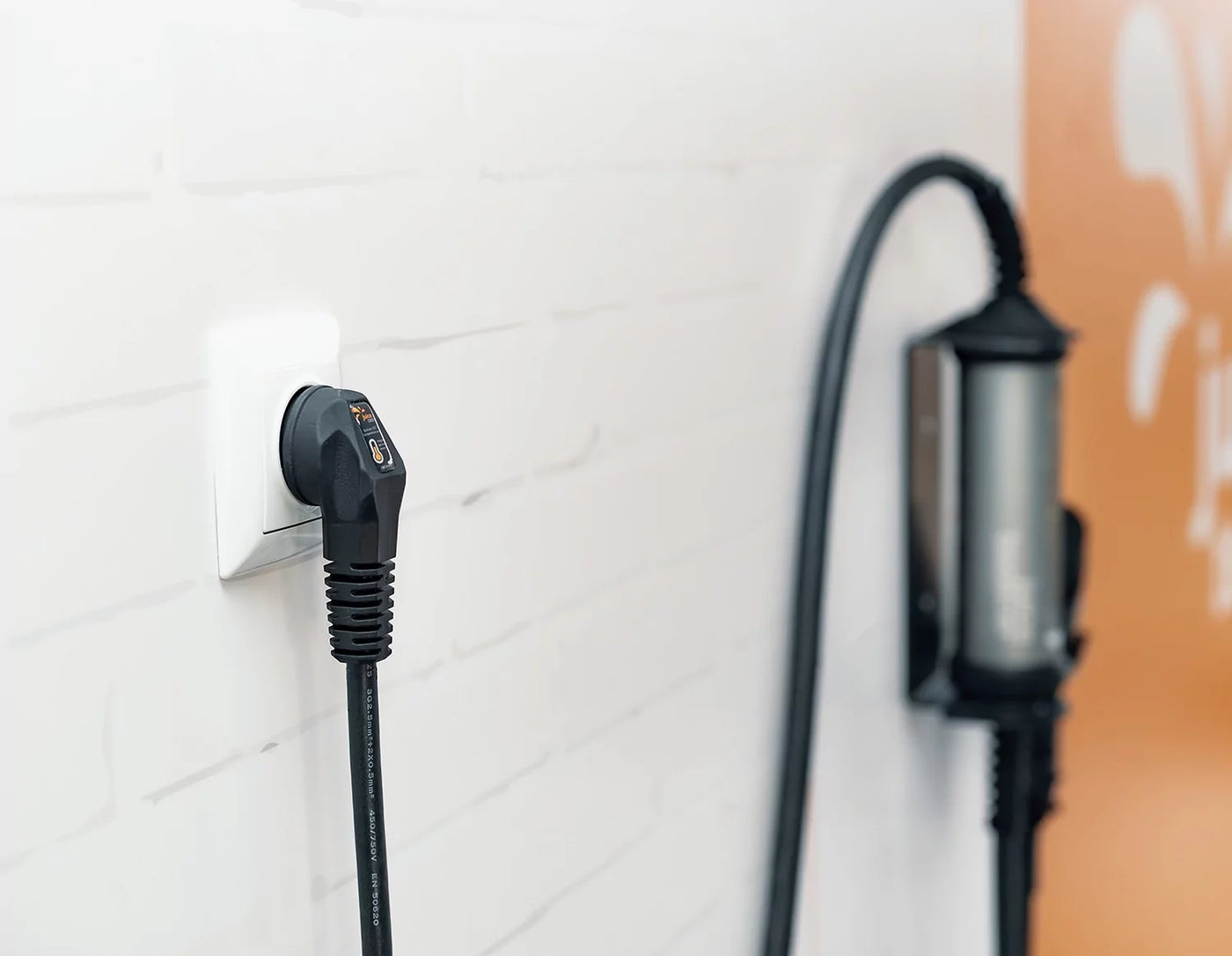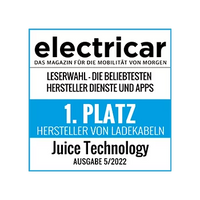JUICE CELSIUS makes the JUICE BOOSTER a pioneer in safety
Charging electric cars at conventional household sockets sounds tempting: They are available everywhere, you don't need an expensive wall box, and the car gets enough power overnight for the next day. However, this is generally not recommended and household sockets are only described as an emergency solution.
Why this is the case, what the dangers are and how JUICE CELSIUS helps to make the charging process safe: the answers to these questions can be found here.
- Charging at a household socket: just an emergency solution?
- What are possible sources of danger and how can they be eliminated?
- Detect overheating where it occurs
- Detailed error detection for maximum property and personal protection
- Conclusion
1. Charging from a socket: just an emergency solution?
A big advantage of electric cars is that they can be charged almost anywhere. If you don't have a fixed wallbox on site, a CEE16 or CEE32 socket is enough to charge with the full power of a mobile 11 kW or 22 kW wallbox. But sometimes there isn't one nearby. You're always left with the household socket. But is that even possible without danger?
We'll say it up front: Yes, with the right equipment it's possible without reservation. To avoid overheating of the power connection and to prevent possible cable fires, we recommend using a mobile wallbox that offers maximum safety - i.e. a JUICE BOOSTER 2 or 3 air with integrated JUICE CELSIUS temperature sensors.
2. What are possible sources of danger and how can they be eliminated?
Especially in old buildings, sources of danger often lurk due to poorly constructed or outdated electrical installations. Electrosuisse, the Swiss trade association for electrical, energy and information technology, lists the following as typical faults in electrical systems:
- damaged cables
- faulty insulation
- defective sockets
- poor quality of the contact points
- ineffective protection against electric shock.
If a device with a high electrical output is connected to an old circuit that has defects, the circuit may become overloaded. For example, insulation defects can cause fault currents, which in turn can cause a fire.
Therefore, only charging stations that have been tested, are fully compliant with standards and meet a high level of safety should be connected to household sockets. Juice was a pioneer in this area and developed a temperature sensor that is installed directly in the plug pins of the household adapter.
3. Detect overheating where it occurs
The patented household adapters (Schuko, T12/T13, Type L and Type G) of the JUICE BOOSTER are all tested by the German VDE (Association for Electrical, Electronic and Information Technologies). The angled design prevents the socket sleeves from becoming worn out due to tension and pressure. But that's not all.
The sensor in the plug pins detects when the socket becomes too hot. The fact that the temperature is registered directly where it occurs is important so that the device can react before the socket overheats and the line is overloaded.
If a defined temperature value (70 degrees Celsius according to the new standard) is exceeded, the plug sends a signal to the control unit. The JUICE BOOSTER then shuts down the charging process in a controlled manner. Why doesn't the JUICE BOOSTER simply switch off? The controlled shutdown protects the sensitive electronics of the electric vehicles: the charger and the electric car are not damaged.
As soon as the pins have reached a normal temperature again, the charging process starts again, but at a lower power level. This is repeated up to three times. This means that the home installation remains intact and the battery is still full. However, if the plug gets too hot again on the third attempt, the charging cycle is completely interrupted for safety reasons.
4. Detailed error detection for maximum property and personal protection
Electric cars are usually charged wherever their owners are - at home, at work, at their holiday home, at a friend's house. However, it is usually not known what condition the existing electrical installation is in. In order to ensure the greatest possible safety for users and the building infrastructure, it is therefore essential to minimize possible sources of error in advance. For safe and reliable operation, a charging station must therefore not only protect against DC and AC errors, but also be able to detect, display and intercept faults such as potential overheating problems at an early stage.
The JUICE BOOSTER 3 air also boasts extensive safety features: If the socket is wired incorrectly or the vehicle draws more power than allowed, the booster detects this and immediately refuses or interrupts charging. Any error can be easily read on the display. The JUICE BOOSTER 3 air also functions as a detector for network-side sources of error and as protection against vehicle-side faults. In this way, not only injuries but also property damage can be consistently prevented.
5. Conclusion
A safe and reliable charging infrastructure is essential for users' trust in electromobility. It is important to prevent any risks - especially when using household sockets as a temporary charging option.
The active temperature monitoring JUICE CELSIUS in household adapter plugs protects both domestic installations and electric vehicles. The timely detection of overheating problems can minimize the risk of fire, thereby increasing user safety. At the same time, the gentle, controlled shutdown of the charging process ensures that the sensitive electronics of the electric vehicles are protected. This technology therefore plays an important role in creating a safe and efficient charging infrastructure that strengthens confidence in electromobility.
Juice was a global pioneer in the field of active temperature monitoring. This measure has since proven so successful in use that other manufacturers have also adopted the approach. The fact that temperature monitoring in chargers to which household adapters are connected has been included in the IEC standard 62752 (ed. 2) shows how important and relevant this is.













